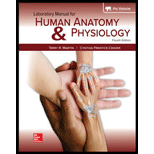
Concept explainers
Chest and shoulder muscles that move the arm at the shoulder joint have insertions on the
a. scapula.
b. clavicle and ribs.
c. humerus
d. radius or ulna.
Introduction:
A joint is a connection between the bones in the body. The function of the joints is to allow various degrees and types of movements in the body. There are certain frictionless joints, such as knee, elbow, and shoulder. These joints can withstand compression and heavy weights easily.
Answer to Problem 1PL
Correct answer:
Option (c), humerus.
Explanation of Solution
Explanation/justification for the correct answer:
Option (c) humerus. Chest and shoulder muscles make the arm movement at the shoulder joint. These two muscles have insertion at the humerus. Hence, this option is correct.
Explanation for incorrect answer:
Option (a) scapula. The scapula is the insertion for the levator scapulae muscle. The scapula is present on both the sides of the upper back and just behind the shoulders. Hence, this option is incorrect.
Option (b) clavicle and ribs. The subclavius muscle has insertion at the clavicle and the rib cage. Hence, this option is incorrect.
Option (d) radius or ulna. The biceps have an origin at the shoulder joint and insertion at the radius, near the elbow joint. Hence, this option is incorrect.
Want to see more full solutions like this?
Chapter 23 Solutions
Laboratory Manual For Human Anatomy & Physiology
- The biceps brachii muscle inserts at ______; its main action is _____ and _____. A. distal phalanges of fingers; extension of fingers B. olecranon of ulna; extension of forearm C. radial tuberosity; flexion of elbow and supination of forearm D. palmar aponeurosis; tenses skin of palm The orbicularis oris muscle has origins at _____ and _____; its main action is to _____. A. occipital and temporal bones; raise eyebrows B. frontal and maxillary bones; close eyes C. zygomatic and maxillary bone; smile D. maxilla and mandible; close lipsarrow_forwardWhich of the following muscles must be cut and reflected completely to expose the splenius muscles? A. Levator Scapulae B. Longissimus thoracis C. Longissimus Cervicis D. illiocostalis Cervicisarrow_forwardA muscle located on the chest wall is the a. trapezius. b. frontalis. c. pectoralis major. d. rectus abdominis.arrow_forward
- Which two hamstring muscles perform external rotation of the knee? A. Semitendinosus and Semimembranosus B. Semitendinosus and Bicep Femoris C. Semimembranosus and Biceps Femoris D. All three hamstring muscles perform external rotation E. No two hamstring muscles perform external rotationarrow_forwardThis muscle depresses and adducts the eye. a. inferior rectus b. inferior oblique c. lateral rectus d. superior obliquearrow_forwardThe orbicularis oris muscle has origins at _____ and _____; its main action is to _____. A. occipital and temporal bones; raise eyebrows B. frontal and maxillary bones; close eyes C. zygomatic and maxillary bone; smile D. maxilla and mandible; close lips The biceps brachii muscle inserts at ______; its main action is _____ and _____. A. distal phalanges of fingers; extension of fingers B. olecranon of ulna; extension of forearm C. radial tuberosity; flexion of elbow and supination of forearm D. palmar aponeurosis; tenses skin of palm In naming muscles according to direction of muscle fibers, _____ means "straight" in reference to the midline of the body; while _____ means the muscle fibers of that muscle are running "at right angles". A. transverse, rectus B. rectus, transverse C. rectus, oblique D. oblique, rectusarrow_forward
- A prominent lateral muscle of the neck that can cause flexion of theneck or rotate the head is thea. digastric. c. sternocleidomastoid. e. platysma.b. mylohyoid. d. buccinator.arrow_forwardWhich muscles raise and spread the ribs? a. External intercostals b. Internal intercostals c. External obliques d. Internal obliques e. Digastricsarrow_forwardWhich of the following muscles does NOT perform hip adduction? A. Gracilis B. Adductor Longus C. Adductor Brevis D. Adductor Magnus E. All the above perform hip adductionarrow_forward
- Which of the following muscles is an extrinsic (Axio-appendicular) muscle of the back? A. Levator Scapulae B. Deltiod C. Erector Spinae D. Splenius Capitisarrow_forwardPutting It All Together A. Humerus B. Brachialis C. Biceps brachii D. Triceps brachii (long head) E. Triceps brachii (medial head) F. Triceps brachii (lateral head) Lateral Posteriorarrow_forwardThe function of the biceps femoris is to A. flex the hip and ankle. B. extend the thigh and flex the leg. C. flex the thigh and extend the leg. D. flex the thigh (with no action at the leg). E. adduct the thigh and extend the knee.arrow_forward

